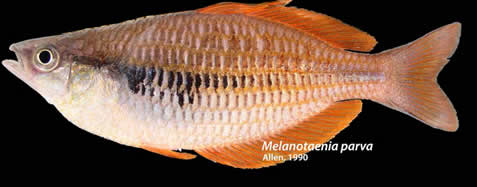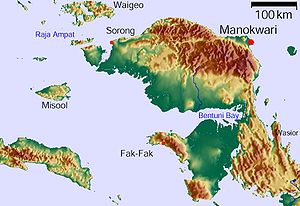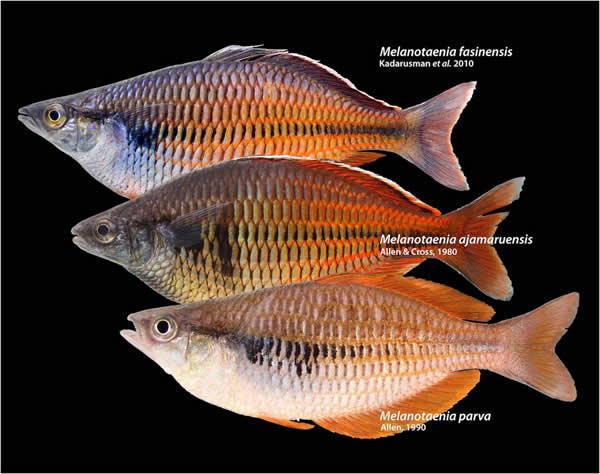Tag Archives: rainbowfish
Extinction Looms Near For Rainbowfish as Lake Dries Up!
A rather magnificent specimen of rainbowfish, prized and coveted for aquarium owners around the globe, is staring into the abyss, and could possibly face extinction since their home is drying up, and alien fish seem to be moving in.
The rainbowfish, Melanotaenia parva, was was described by accomplished ichthyologist Dr. Gerald Allen back in 1990. These magnificent rainbowfish hail from Kuromoi Lake on the Bird’s Head Peninsula in West Papua, Indonesia.
At the time of their discovery, the rainbow fish were abundant, however the water seemed to be receding. The level of the water of the lake had already reached levels lower than the outlet with the Yakati River, however more unsettling was the discovery that a non-native Tilapia had made its way on to the scene. Now, researchers have commenced a new study and have found some good news, and bad news.. Good news, a bright colorful new species of rainbow fish.. Bad news.. Lake Kuromi, where these rainbow fish call home, is almost completely dry.
Now a new study by scientists who have just described a new species of rainbowfish from the Bird’s Head Peninsula have shown that its home – Lake Kuromoi – is now almost completely dry.
These startling discoveries were made back in June 2007, but have only now made their way to the public eye. To top it all off, as if having your home dry out wasn’t bad enough, the rainbowfish now need to compete for survival with a rogue species of Tilapia.
What is to become of these poor rainbowfish?
Melanotaenia fasinensis – New Rainbow Fish Named From West Papua
Researchers have just discovered and described a new rainbow fish which hails from West Papua, Indonesia.
Ichthyologists, also known as fish scientists to us normal folk, Paradis, Pouyaud, Kadarusman and Sudarto are credited with the find and have dubbed the new kind of rainbow fish Melanotaenia fasinensis. They published this in a paper in the journal Cybium.
The new rainbow fish was found in the Fasin River, just about 25 clicks west of Lake Ayamaru on the West Papua’s Bird’s Head Peninsula.
The little guy was found floating about in a 1 meter deep, 4.5 meter wide stream, surrounded by flush greenery.
This rainbow fish lives over a substrate of gravel, and makes its home amongst limestone boulders and debris of fallen branches from the forest.
The Fasin River also boasts a myriad of other species such as sleeper gobies, and different types of crayfish.
The Bird’s Head Peninsula in Indonesia is considered a hotspot when one is going about and trying to find rainbow fish. There are many different kinds of rainbow fish which also call the place home, and they all seem to live in harmony with one another.
It’s good to see that the scientific world has not given up on seeking new kinds of this beautiful fish. Not only are they pretty to look at, but they are key to the survival of all the species in that ecosystem.
Some people have been trying to catch them and sell them off as pets, however an ordinance is in place telling people to refrain from such a practice.
Madagascar!
Madagascar, a large island situated in the Indian Ocean off the south-eastern coast of the African continent, is home to an astonishing array of flora and fauna. Madagascar, then part of the supercontinent Gondwana, split from Africa about 160 million years ago and became an island through the split from the Indian subcontinent 80-100 million years ago.
Madagascar is now the 4th largest island in the world and its long isolation from neighbouring continents has resulted in an astonishingly high degree of endemic species; species that can be found nowhere else on the planet. Madagascar is home to about 5% of the world’s plant and animal species, of which more than 80% are endemic to island. You can for instance encounter Appert’s Tetraka bird (Xanthomixis apperti), the carnivorious Fossa (Cryptoprocta ferox) and over 30 different species of lemur on Madagascar. Of the 10,000 plants native to Madagascar, 90% are endemic.
The diverse flora and fauna of Madagascar is not limited to land and air; you can find an amazing array of creatures in the water as well – including a rich profusion of endemic fish species. Unfortunately, the environment on Madagascar is changing rapidly and the fish – just like most of the other creatures – risk becoming extinct in the near future.
The fishes of Madagascar currently have to deal with four major threats:
- Deforestation
- Habitat Loss
- Overfishing
- Invasive species
In a response to this, and to educe people around the world about the fish of Madagascar, aquarist Aleksei Saunders have created the website Madagascar’s Endangered Fishes on which he shares his knowledge of Madagascan fish species and the perils they’re facing, but also highlights all the things we can do to improve the situation.
The site focuses on freshwater fish conservation and captive breeding, since collection of wild fish to bring endangered species into captivity for managed reproductive efforts plays a large part of the conservation effort in Madagascar.
In addition to the website, Alex is also gives power-point presentations on husbandry and conservation breeding of Madagascar’s endemic fish fauna, since more and more aquarists around the world are taking a large interest in doing their part to help endangered fish species.
Alex has worked with fish since 1990 and it was through his work as an aquarist at Denver Zoo he became enthralled with the ichthyofauna of Madagascar. During the early 1990s Denver Zoo started a conservation program with the endemic freshwater fishes of Madagascar and in 1998 Alex got the chance to pay his first, but certainly not last, visit to the island. Today, his trips primarily focus on educating the Malagasy on their wonderful natural heritage and ways of conserving it, assessing the condition of native freshwater habitats and the fish population therein, and collecting wild fish for managed captive breeding. Alex now manages on of the most diverse collections of Madagascan endemic fishes in North America, including 5 species of rainbowfish, 4 species of cichlid, and 3 killifish species.
With this site I hope to educate, motivate, and stimulate people into action to help save Madagascar’s endangered fishes. Please look around the site. There are sections for fish hobbyists, adventure travellers, conservation biologists, and just those curious about the world in which we live.
Cheers,
Aleksei Saunders


